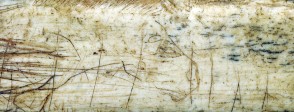Show students the image of the main object on the whiteboard. Can they see what animal has been drawn on it? How has it been drawn? What has it been drawn on? Looking at the shape of the bone, can students work out where in the body of an animal it came from?
The following activities involve the students moving out from the engraved bone to consider the nature of life in this period and the purpose of this sort of object.
Print out images of the Creswell Crags horse and of the Ice Age objects with animal representations in A bigger picture. Give students details of the ages of these objects and where they were found. Ask them to list as many reasons as they can for why people may have made these objects. Ask them to choose which they think is the most likely reason and why. Are they religious objects, good luck charms or even toys? What do the students think?
Expand this with thinking about why they portrayed these particular animals? Do we think they hunted wolverines for food? What about horses? Can students come up with some other reasons people might have drawn animals?
Ask the students to locate the find spots of the objects in A bigger picture and create a display. This could be added to with objects from wider research. Identify the main areas for finds from this period. Which is the farthest north? What kind of sites have they been found in – caves or open air sites? Did they live in these places, or were they special?
Use just the images of engraved bones from A bigger picture: the horse from Creswell Crags, the wolverine from Les Eyzies and the reindeer and ibex from Courbet cave. Students could experiment with carving and engraving their own Ice Age figures from materials such as soap or chalk. Ask students what tools Ice Age artists would have needed to engrave the bone. Show them the picture of the flint burin from the For the classroom tab on the whiteboard.
Here are two wider enquiry themes.
Why and how did the hunters get to Creswell Crags? Investigate what reasons prehistoric people had for moving and the forms of transport that may have been available in different periods. Discuss the reasons people may have for staying in one place. This enquiry could begin from or lead into students’ family histories of migration.
What is art? The 2013 British Museum exhibition Ice Age Art made the link between Ice Age art and modern artists such as Picasso. Have a discussion with your students about what art is. Is it just a picture or a sculpture? Does it have to be well-made? Does it have to convey emotion? Is the engraved bone from Creswell Crags art? See the links in About the object for resources from the exhibition.


